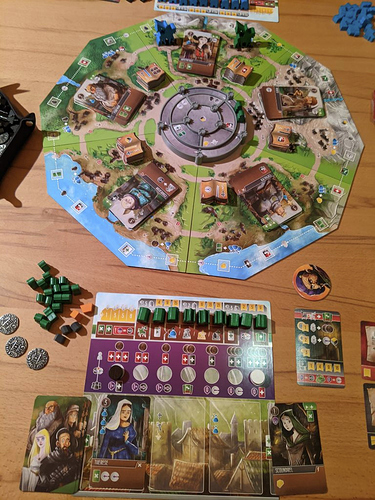After my copy of Viscounts of the Westkingdom arrived yesterday, I couldn’t wait to try it out. Normally I would have learned the rules and played 2 handed before playing with my partner but after some sub-optimal recent teaching experiences (before the thread happened), I decided to try a new approach of learning the game together. I wouldn’t do this to anyone else because it takes much longer learning from the rulebook than getting an explanation from someone who knows the game but I needed to verify if it was my teaching that was ruining the games. (spoiler: mostly the answer is yes, I forget too many details when teaching)
So Viscounts is the third in the trilogy with Architects and Paladins preceding it. Architects has seen lots of love in this thread, Paladins I haven’t seen much. Of the three I’d say Architects is the easiest and least complex both to teach and as gameplay and Paladins is at the opposite end with Viscounts ranking in the center in both aspects.
This is a combination of several mechanisms, none of which completely dominates the game so when you look up what BGG says this game is (which I cannot because BGG appears to be down oO) there will be a list of things that tells you very little what this game is actually like.
In general–just like with its siblings–you win by collecting VP in different forms in this game. The VP are added up at the end, there is no VP track. The game plays over a variable number of rounds in which players take their turns one after another.
The game ends when the “Kingdom” has either sunk into poverty (by players taking up a certain number of debt cards) or become prosperous (by players taking a certain number of deed cards). It is possible for both poverty and prosperity to exist in the Kingdom because when the game end is triggered one more full round is played allowing everyone a last grab at VP.
A player turn consists of multiple phases that are helpfully lined out on the playerboard using already familiar iconography that is very much like the previous two games.
- Phase 1: (tableau building) play a card and resolve effects
- Phase 2: (point to point movement) move the big Viscount figure on the board
- Phase 3: (action selection) Take one main action. The location of your Viscount determines what type of action you can take. The strength of an action is determined by the symbols in your little card tableau (plus other sources). There are four main actions you can take which–except for trading–contribute to your VP:
- trading for resources,
- building one of your little houses on one of the slots in the outer circle,
- scribing a manuscript or
- placing some of your workers in the castle at the center.
- Phase 4: (deck building) Buy the current card next to your viscount figure
- Phase 5: (West Kingdom specific)… this wouldn’t be WK if there wasn’t some kind of virtue vs corruption gameplay and in this phase players check if their virtue and corruption have “met” somewhere on the track and resolve the situation by gaining either deeds or debts (or both). This is the main driver for ending the game
- Phase 6: draw cards…
Each main action can cascade into a variety of effects making decisions tough. The randomness in the game comes from shuffling your own deck and from the random setup of the cards and manuscripts at the start. Everything else is deterministic.
I found the decisions interesting but not too tough. My partner said he had no idea what he was doing throughout the game. We each fell into quite different strategies. I added a lot of workers to the castle while he bought a lot of manuscripts. We weren’t quite sure how each of those would give VP and the end result was really close (I won with 75 to his 72). If we had known a bit more about the manuscripts I think he could easily have pulled of a victory.
We did reasonably well for a first game but since neither of us could gauge the importance of resources or how hard it could be to get the larger buildings on the board our strategies regarding which cards to buy and play were rather “uninformed”. I expect this to go much smoother in further games.
Including both of us learning the game from scratch it took us about 3 hours to finish the first game.
I think I enjoyed it more than my partner but that is not that much of a surprise, I have less trouble playing without quite knowing what I am doing. He is more of the type who needs to have fully grokked a game. Definitely looking forward to try again. There is a solo-mode like in the other two games and the Tome Saga comes with a campaign mode and coop modes which I am very keen to try.




